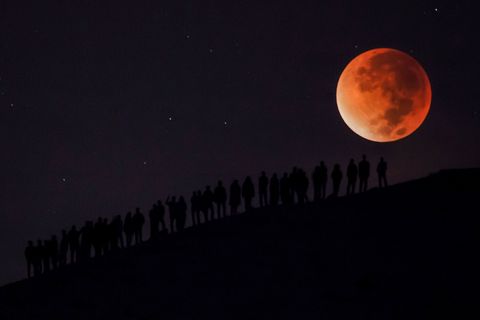Long before calendars and planners were around, the Native Americans kept track of the months and seasons by studying the moon, according to the
Farmers' Almanac. Today, we still use many of the nicknames and terms they coined to refer to various moons, plus a few new names like
supermoons and
blue moons, all of which describe the moon's look, distance from the earth, or its number of reoccurrences.
So the next time you look up into the nighttime sky and see a full moon, which occur every 29.5 days, use this handy guide to figure out exactly what you're looking at.
Supermoon
These full moons are especially bright and large because they're closer to Earth than your typical lunar sighting—and they can cause higher than usual tides, according to
The Telegraph.
There will be four in 2017, but only the one in December will be visible.
Micromoon
A micromoon is the opposite of a supermoon—this teeny and dull full moon appears when the moon is at its farthest distance in its orbit, according to
Earthsky.org.
Blood Moon
This full moon occurs during a total lunar eclipse, and radiates red or orange hues.
Blue Moon
Blue moons aren't actually blue in color. The term refers to any second full moon of the month, according to
Earthsky.org. There are also seasonal blue moons, which are considered the third or fourth blue moon in a season. Occasionally, onlookers may see a blue-ish colored moon in the sky, but this occurs very rarely and is due to dust or smoke particles in the sky.
Wolf Moon
This full moon occurs in January—a time when tribes often heard wolves howling outside their villages, according to
Farmers' Almanac.
Snow Moon
The origin of this name is pretty obvious: the full moon in the month of February would light up the sky and illuminate snow on the ground.
Worm Moon
The full moon occurring in March is called the "worm moon" due to the resurgence of worms in the ground as the seasons change from winter to spring.
Pink Moon
A pink moon isn't typically a pinkish hue. In fact, this moon, which is visible in April, gets its name from the pink wildflowers, which grow in Canada and the U.S. around this time.
Flower Moon
The full moon in May is named after the abundance of plants in bloom at this time.
Strawberry Moon
Another more obvious name here,
this June moon occurs when strawberries are in season.
Buck Moon
This July moon marks the time of year when a buck's antlers are nearly, if not entirely, grown. Some tribes called the full moon occurring around the same time of year a "thunder moon," after summertime thunderstorms.
Sturgeon Moon
Native American tribes used this fish, which is readily available in the U.S. and Canada during the late summer, to refer to the full moon in August.
Corn Moon
This beauty occurs during the month of September, when it's time to harvest corn.
Harvest Moon
The full moon that's closest to the autumnal equinox is known as the harvest moon. It usually occurs in September, but occasionally you'll see the beauty light up the sky in October.
Frost Moon
This full moon, which takes place in November, marks the arrival of cold weather.
Cold Moon
Also called a "Long Nights Moon," this one indicates the time of year when nights are the longest and coldest.
















No comments:
Post a Comment